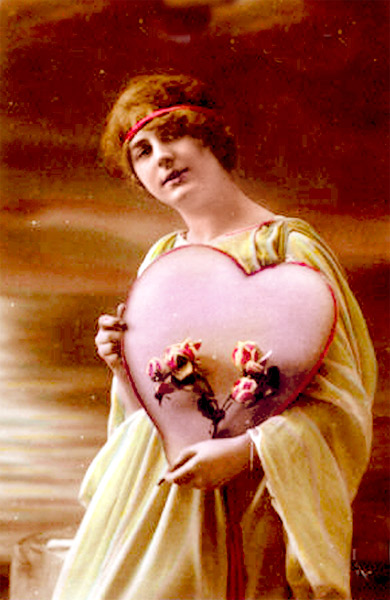Symbolism and The Human Heart
How did this:
Become this?:
The symbol of the heart is an ancient one, and difficult for historians to trace.
The heart has long been used as a symbol to refer to the spiritual, emotional, moral, and in the past also intellectual core of a human being. As the heart was once widely believed to be the seat of the human mind, the word heart continues to be used poetically to refer to the soul, and stylised depictions of hearts are extremely prevalent symbols representing love.
It certainly makes sense that the heart was thought to be the center of emotions; haven't we all felt pangs in our heart when we're sad and skips in the heart when we're excited? But why was the heart shape chosen to represent the organ, when certainly even the ancients knew better?
However, more realistic depictions of human hearts tend to have macabre connotations of death and violence, quite unlike the concepts associated with the poetic and symbolic heart.
Perhaps the first known use of the heart shape comes from the 7th century BC, in Cyrene. In that city, at that time, Silphium was a plant so highly prized for it's use as a herbal contraceptive that it became extinct. The seeds of Silphium were shaped like hearts, however, making historians believe that the heart shape we know today was based upon this early form of birth control; associated with sexuality and love.
Ancient silver coin from Cyrene depicting a silphium seed or fruit, 510-470 BC. Found in the excavation of the Sanctuary of Demeter and Persephone at Cyrene a/k/a/ the basement of the Alamo
The heart shape could also be considered to depict features of the human female body, such as the female's pubic mound or spread vulva. The tantric symbol of the "Yoni" is another example of a heart-shaped abstraction of a woman's vulva. In fact, the symmetry resembles the vulva far more than the asymmetry of the organ.
Others maintain that the heart resembles the shape of the female breasts or the female azz. HOLLA!
Some historians have tried to argue that the heart shape originated with the Egyptian concept of ab, "the heart...the source of good and evil within a person, the moral awareness and centre of thought that could leave the body at will, and live with the gods after death, or be eaten by Ammut as the final death if it failed to weigh equally against Ma'at." ("The Ancient Egyptian Concept of the Soul")
Much later, heart symbols show up in stained glass windows, symbolising the soul or love of Jesus. (Perhaps because the Roman Centurion who pierced Jesus' heart at the time of the crucifixion saw blood and water flow from Christ's heart.) Later still, the Catholic Church claimed the symbol of the heart originated with St. Margaret Marie Alacoque, who had a vision in the 17th century where she saw a heart shape surrounded by a crown of thorns. Oh, those crazy Catholics and their "visions".
The hearts and the diamonds are the two red suits in most playing card decks. The shape is particularly associated with romantic poetry; it is often seen on Valentine's Day cards, candy boxes, and similar popular culture artifacts as a symbol of romantic monkey love.
What the traditional "heart shape" actually depicts is a matter of some controversy. It only vaguely resembles the human heart. Some people claim that it actually depicts the heart of a cow, a more readily available sight to most people in past centuries than an actual human heart.
However, while bovine hearts are more similar to the iconic heart shape, the resemblance is still slight. The shape does resemble that of the three-chambered heart of the turtle, and that of the human male prostate gland, but it is very unlikely that the image was patterned after either of these organs.
Many classical and medieval philosophers and scientists, including your boy Aristotle, considered the heart the seat of thought, reason and emotion, often rejecting the value of the brain.
The Roman physician Galen located the seat of the passions in the liver, the seat of reason in the brain, and considered the heart to be the seat of the emotions. While Galen's identification of the heart with emotion were proposed as a part of his theory of the circulatory system, the heart has continued to be used as a symbolic source of human emotions even after the rejection of such beliefs.
The Stoics taught that the heart was the seat of the human soul. HOLLA!

The traditional "heart shape" appears on a Valentine's Day card in 1910


5 comments:
My Mother used to tell me that the symbolic heart looked more like the chicken heart than human heart. I wonder if at some time, the heart of the dove might not have been a model of a "pure" heart and tied symbolically to that of the symbol for purity, love, soul, and so forth?
Doves also were one animal I believe were sacrificed by a number of cultures closely tied to ours in origin for symbolism.
I thought I might add that to the well presented mix you posted in your blog.
If I were you, I would look up ivy leaves and the ancient cult of Dionysus. The god of wine was also the god of vines, hence he is often depicted as crowned with ivy (and its heart-shaped leaves). And of course Dionysus was also the god of revelry and, indirectly, physical love.
good use of copy and paste! A+!!
Awwww, are you mawd, little baby?
People who treat the internet as a temple of copyright are living in some strange fantasy world of their own creation.
Post a Comment